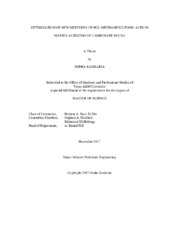| dc.description.abstract | One of the factors for the success of matrix acidizing of carbonate reservoirs is the selection of appropriate stimulation fluids. Till date, the most common acid for carbonate stimulation is HCl due to ease of its availability, inexpensiveness, and soluble reaction products. However, HCl has many drawbacks. It is associated with high corrosion issues and rapid reaction rate with calcite in bottomhole conditions, which, in turn, causes face dissolution problems. Thus, other alternatives are gaining attention in the oil industry.
Methanesulfonic acid (MSA), an organic acid, offers a viable alternative to HCl as they address the issues of corrosion and face dissolution rendered by HCl. In addition, MSA is environmentally benign. In literature, coreflood studies have been carried out using 10 wt% MSA in carbonates at 250°F to investigate its effectiveness. The kinetic parameters of various concentrations of MSA at different temperatures using rotating disk apparatus (RDA) have also been reported. However, MSA is expensive. This study proposes to use a blend of HCl and MSA for carbonate stimulation while enhancing the properties of HCl.
The goal of the present work is to evaluate the performance of the blend and optimize the concentration of individual acids in it using coreflood studies. Three different ratios of HCl and MSA will be studied by conducting coreflood experiments with 6-in. long Indiana Limestone cores at 250°F. The blend performances will also be compared to the equivalent concentration of individual acids at the determined optimum injection rate. The effluent samples will be analyzed for pH, calcium concentration, and unconsumed acid concentration. Cores will be analyzed using CT scan for identifying wormhole structures and tortuosity determination. The optimum blend will be tested for dissolution kinetics study (mass-transfer or surface reaction limited regime) using RDA.
The advantages rendered by the new acid mixture compared to other standard systems currently used in the oil industry include: (1) extended wormholes that will ultimately lead to enhanced well productivity, and (2) cost-effectiveness in carbonate stimulation. | en |


